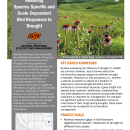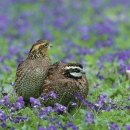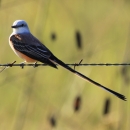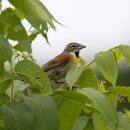Location



















States
OklahomaEcosystem
PrairieIntroduction
Droughts can negatively affect ecosystems by reducing water availability and changing vegetation cover, influencing agricultural productivity, wildlife populations, and increasing the risk of wildfire. Droughts can occur across various time scales, influencing different hydrologic attributes, and leading to significantly different ecological effects. It is important for researchers to understand the role of temporal scale (i.e., duration and timing) when evaluating drought effects to better support conservation and management. For example, researchers studying the effects of climate change climate change
Climate change includes both global warming driven by human-induced emissions of greenhouse gases and the resulting large-scale shifts in weather patterns. Though there have been previous periods of climatic change, since the mid-20th century humans have had an unprecedented impact on Earth's climate system and caused change on a global scale.
Learn more about climate change may focus on droughts that extend for years or decades. Conversely, researchers studying drought effects on winter snowpack may focus on shorter droughts.
More specifically, drought can change habitat, food availability, or cause physiological stress in birds. These changes can negatively affect birds by reducing breeding success, reducing species diversity, and causing populations to disperse or move to different areas in their ranges. Additionally, because different bird species have different diets, habitat requirements, behaviors, and physiology, all bird species do not respond equally to drought.
Correspondingly, droughts across different time scales can affect bird species differently. For example, one bird species’ presence in an area (occupancy) may change in response to an acute drought episode during a single breeding season, but another species may only have occupancy shifts in response to multi-year droughts. Further, these complex and diverse potential drought effects are difficult to quantify because of limited time scales historically used in bird ecological studies. Particularly, literature has focused on annual drought periods more so than the effects of shorter, acute drought episodes, such as 1-month periods.
To improve scientific understanding of species-specific and time scale-dependent responses to drought, researchers from Oklahoma State University used data from the North American Breeding Bird Survey (BBS) and the Standard Precipitation and Evapotranspiration Index (SPEI) to determine how species-specific occupancy shifts in areas experiencing drought across different time scales, and whether drought alters bird distribution. Researchers used bird occupancy data within the US EPA Level II Ecoregion, the South Central Semi-Arid Prairies, in the Great Plains of North America. In addition, researchers utilized the SPEI to determine drought periods of various time scales from 2000-2015 derived from PRISM climate data.
Key Issues Addressed
Existing literature about the response of bird species to drought often uses three-month time scales that coincide with the average bird breeding season, or compares wet years to dry years (annual scales). Using these common time scales that do not always coincide with a particular species’ life history requirements or previously recorded drought responses may miss important nuances in bird response to drought, potentially misleading management efforts. However, there is relatively little research on how or if studying shorter or longer scales affects conclusions about specific bird species’ presence and distribution during drought.
Further, studies that investigate changes in abundance and long-term shifts of bird populations within and outside their ranges are common, whereas less is known about short-term changes in local bird occupancy in response to drought. Research on bird responses across a diversity of drought scales can be beneficial to conservation efforts because it can indicate habitable conditions during a drought. For example, if a significant portion of a bird population moves to novel areas of their range during droughts, these areas could then be considered for conservation management.
Researchers chose to study bird species in the Great Plains because of the recent increasing aridity of the region and predicted drought increases. Climate change will continue to increase weather extremes, like the occurrence of droughts, in the Great Plains. Further, Great Plains bird species have the fastest declining populations in North America, making their conservation urgent.
Project Goals
- Address research gaps in bird literature regarding bird species’ responses to drought at different time scales
- Determine which time scales capture the most significant and accurate bird responses to drought (e.g., changes in bird occupancy in an area experiencing drought)
- Assess whether drought intensity changes bird distributions
Project Highlights
- North American Breeding Bird Survey (BBS): Bird occupancy data from 2000 to 2005 drawn from the North American Breeding Bird Survey (BBS) was vitally important for tracking long-term occurrences and distributions of bird species. Thousands of skilled citizen scientists document bird occurrence across the same roadside transects throughout North America for the BBS every year, making it a primary source of reliable quantitative bird occurrence data for over 500 species. Using various filters, researchers narrowed their focus to BBS data on ten Great Plains bird species: American Robin (Turdus migratorius), Dickcissel (Spiza americana), Grasshopper Sparrow (Ammodramus savannarum), Horned Lark (Eremophila alpestris), Lark Sparrow (Chondestes grammacus), Mourning Dove (Zenaida macroura), Northern Bobwhite (Colinus virginianus), Northern Cardinal (Cardinalis cardinalis), Scissor‐tailed Flycatcher (Tyrannus forficatus), and Western Kingbird (Tyrannus verticalis).
- Standardized Precipitation Evapotranspiration Index (SPEI): The SPEI provided researchers flexibility in determining shorter-scale and longer-scale droughts, their intensities, and where they occurred to understand how bird occupancy changes with different scales of drought. The SPEI draws on at least 30 years of precipitation and evapotranspiration data to determine drought patterns. Evapotranspiration is an important metric for analyzing drought intensity at shorter time scales because it provides a more accurate account of water entering and leaving the system than analyses that solely rely on precipitation data. Researchers used 1‐, 4‐ (short-term scales), 8‐, and 12‐month (long-term scales) drought periods that ended in April or June to identify droughts and their intensities. These scales are important because they align with territory establishment and peak nesting of various species, and also align with BBS data which is collected in May and June. Scales were drawn from Albright et al. (2010).
- Bird Responses to Drought: Researchers determined birds were drought-responsive based on the likelihood they were present when drought of different scales and intensities was occurring. Comparing drought data from the SPEI to bird occupancy data from the BBS, researchers concluded that when there is drought across all time scales, bird occupancy within their ranges decreases for all drought-responsive birds. Still, the timescale of drought response was different among many drought responsive species. Drought-responsive species included American Robin, Dickcissel, Grasshopper Sparrow, Horned Lark, Northern Bobwhite, Scissor-tailed Flycatcher, and Western Kingbird, whereas species that did not respond to drought were Lark Sparrow, Mourning Dove, and Northern Cardinal.
Lessons Learned
Im-peck-able Timing: Dickcissel occupancy increased in previously unoccupied areas in the middle of their range during 8-month drought windows–a new and critical piece of information for Dickcissel conservation.
Bird occupancy in an area experiencing drought most significantly decreased in five species during longer drought time periods (8-month and annual) compared to shorter drought time scales: Northern Bobwhite, Scissor-tailed Flycatcher, Horned Lark, Dickcissel, and Grasshopper Sparrow. These birds are from the grassland guild (different bird species that exploit similar resources). These results support previous knowledge that birds from the grassland guild are sensitive to weather extremes. The grassland guild species have also experienced recent population declines, highlighting the relevance of this research to understand their behavior during drought, and better inform their conservation. More specifically, Northern Bobwhite, Dickcissel, and Horned Lark rely on vegetation as their primary food source. Researchers hypothesized they respond most strongly to long-term droughts because long drought periods affect plant cover. Reduced plant cover changes and plausibly reduces the birds’ food and nesting resources over annual periods of drought.
Further, American Robin and Western Kingbird abundance decreased most significantly during shorter drought periods (1-month and 4-months), further highlighting bird species response variability. Researchers did not determine the exact mechanisms for stronger responses to shorter drought scales. Though there is some evidence of short-term bird dispersal, they hypothesized that bird behavior (and therefore, detectability) could also decrease because of short-term weather events. These conditions may affect their food resources, causing the birds to forage longer, which is time not spent singing in their territories. If BBS surveyors cannot see them or hear them, their detectability will decrease and be reflected in the dataset. Though this may not indicate a true occupancy change (i.e., birds may still be present), it nonetheless indicates a behavioral response to drought.
Researchers used long-term data (16 years of BBS data and 30 years of climate data) to study drought related bird responses. Long-term data allows higher confidence in results because it allows for multiple drought events and a variety of moisture conditions to be represented in the data. Further, using data from the BBS expedited the research process compared to collecting new data for this specific research project. If data were collected for this project, there would be less data over a shorter period of time, due to funding and time restrictions. Additionally, it was helpful for researchers to have previously conducted similar field research to the BBS in ecologically similar areas studied. This prior experience allowed researchers to be more familiar with the study system as well as how the data are structured, which helped them interpret results in the correct context. Overall, the study successfully added to the growing body of literature about the importance of temporal scale when considering drought impacts to natural systems.
Next Steps
- Research the specific mechanisms of different bird species responses to drought
- Identify the areas that Dickcissel tend to disperse to and figure out what is different about those sites (why do Dickcissel select them when conditions are unfavorable?)
- Continue sharing and communicating research findings from this study with managers and the public to improve awareness and conservation of birds
Funding Partners
- U.S. Department of Agriculture
- National Institute of Food and Agriculture
- Department of Natural Resource Ecology and Management at Oklahoma State University
- Oklahoma Cooperative Fish and Wildlife Research Unit
Resources
- Cady et al. (2019). “Species‐specific and temporal scale‐dependent responses of birds to drought.” Glob Change Biol. 25(8):2691–2702. https://doi.org/10.1111/gcb.14668
- North American Breeding Bird Survey
- PRISM Dataset
Contacts
- Samantha Cady, Graduate Research Associate, Oklahoma State University: smcady@okstate.edu
- Tim O’Connell, Oklahoma State University: tim.oconnell@okstate.edu
CART Lead Author
Nicole Williams, CCAST Student Intern, University of Arizona
Suggested Citation
Williams, N., Cady, S.M., O’Connell, T.J., Loss, S.R., Jaffe, N.E., and Davis, C.A. (2022). “Modeling Species‐Specific and Scale‐Dependent Responses of Birds to Drought.” CCAST. Retrieved from https://www.fws.gov/project/modeling-bird-responses-drought











